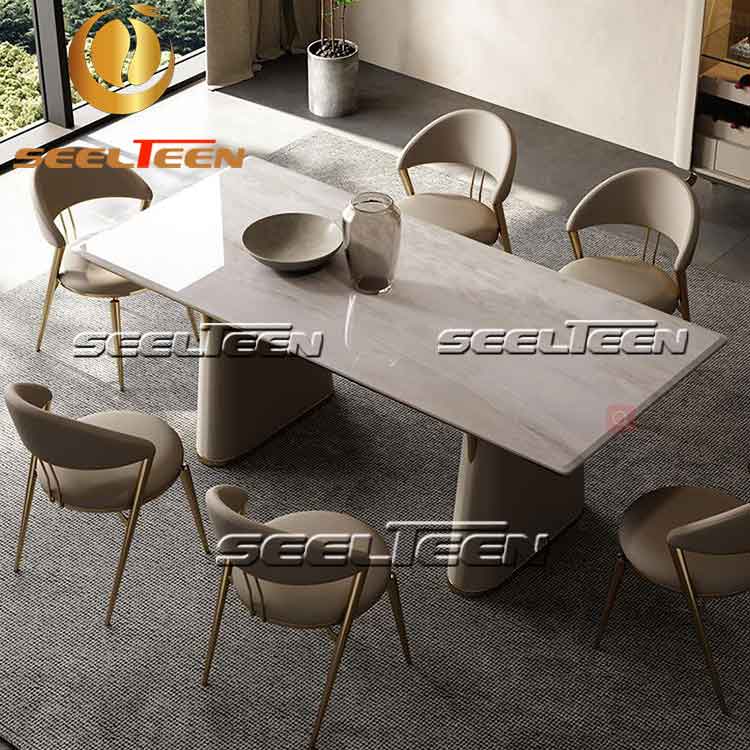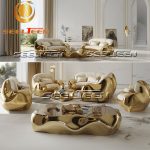Dining Chairs and Table: How to Mix and Match?
A well-styled modern dining room doesn’t always come right out of the box. Mixing and matching furniture pieces gives a room some soul, and following a few guidelines will keep the room looking cool rather than chaotic.
For decades, dining “sets” have been a go-to for furnishing this all-important space in the home. Purchasing an out-of-the-box matching set is an easy way to complete a room once and for all, but to make a room feel curated and special, the key is often about coordinating pieces rather than matching them.
Putting together a dining set using various designs, brands and even materials can give a complete and stylized look. While mixing and matching dining chairs can be a tricky task, following a few simple style guidelines will help make sure the space looks intentional rather than haphazard.
1. Match wood finishes
One of the most basic ways to create a more complex dining set is to mix up styles and shapes—but use one consistent type and finish of the wood. This works better with neutral finishes like walnut, teak and maple that are often easier to find across various collections or furniture brands. Sticking to a certain wood finish narrows down the pool of choices, but still leaves a bevy of options that don’t have to be anywhere near matching.
Try it: A stout, clean-lined dining table pairs well with a more stylized chair in the same walnut finish, creating a tailored look from two entirely different styles.
2. Keep it monochromatic
Disparate shapes, styles and finishes can be unified by sticking to a single color, ideally black or white. This can even help bring together various materials if working with a selection of chairs and tables in metals, woods, plastics, or even marble.
Try it: Combine styles and silhouettes, no matter how different they may seem. Using the same color allows multiple standout designs to have a seat at the table without overwhelming each other.
3. Shake up a single style
If the shapes and silhouettes aren’t lining up, bring together a mismatch of styles with a common design theme. Using different pieces that all fall under one look can be a tailored way to showcase an eclectic style. Knowing what the space will look like will help guide in choosing pieces that fall under that umbrella.
Try it: Combine a playful riff on a classic theme, like modern meets antique. The result is a graceful aesthetic that is decidedly contemporary and can add a playful touch to a formal dining room. Various finishes can be unified using a common design key. To keep the overall collection cohesive, make sure that there’s a thread that ties the various parts together. Try using iconic or antique shapes for an unexpected twist. Clean-lined versions of historical shapes can be a common ancestor for mixed materials.
4. Pair bold colors
A pop of color has been a wardrobe staple for ages, and that advice crosses over into interiors especially well. In the dining room, try choosing one bold shade that can bring together different furniture pieces. The key here is to maintain a common language among the shapes found between the tables and chairs—for example, if working with a curvaceous table, look for that same shape in chairs as well. If going with colored chairs, a neutral table is a no-fail way to keep it all in line.
Try it: Keeping within the same model of chair while selecting a few different colors helps this dining collection look put together, not thrown together.
5. Mix and match
Matching is less important than an overall pulled-together aesthetic. Mixing a dining table and dining chairs from different eras, different finishes, and different design styles can help create an approachable elegance that is calming and articulate. A mixed approach, done successfully, will make people stop and consider all the decisions and materials being combined — much like a great art piece will collect viewer’s attention, probing their curiosity.
Try it: Combining natural wood with painted wood creates a unique look in the room, bringing brilliance into the space.
6. Seating height and spacing
When choosing a dining chair, counter, or bar-height stool for your space, it is the seating height—not overall height—that is the most important factor in determining the right fit. For proper leg clearance and ergonomic comfort, the general rule of thumb is to pick a chair or stool with a seat height that is roughly 12 inches below the table/counter/bar surface.
For adequate elbow and breathing room for guests, ideally, there will be one chair or stool for every 24 inches of table or counter surface.
The lesson? Don’t be afraid to collect the furniture pieces that are truly loved for fear that they won’t “fit” together. Coordinating a few key elements will bring it all together into a comfortable, beautiful space.
Welcome to contact us to get the latest price list!
Do you need to read another article? Please click on this: Hospitality Tips: Designing a Guest Room like a Hotel Suite
Find us on Facebook, Instagram and don’t miss a single breath










